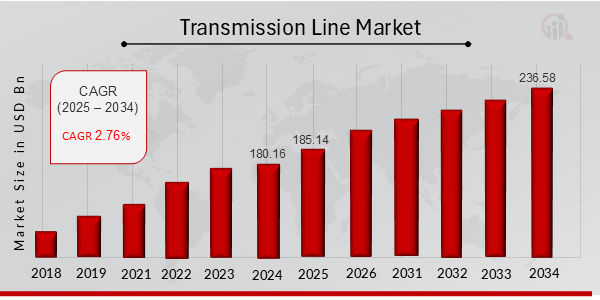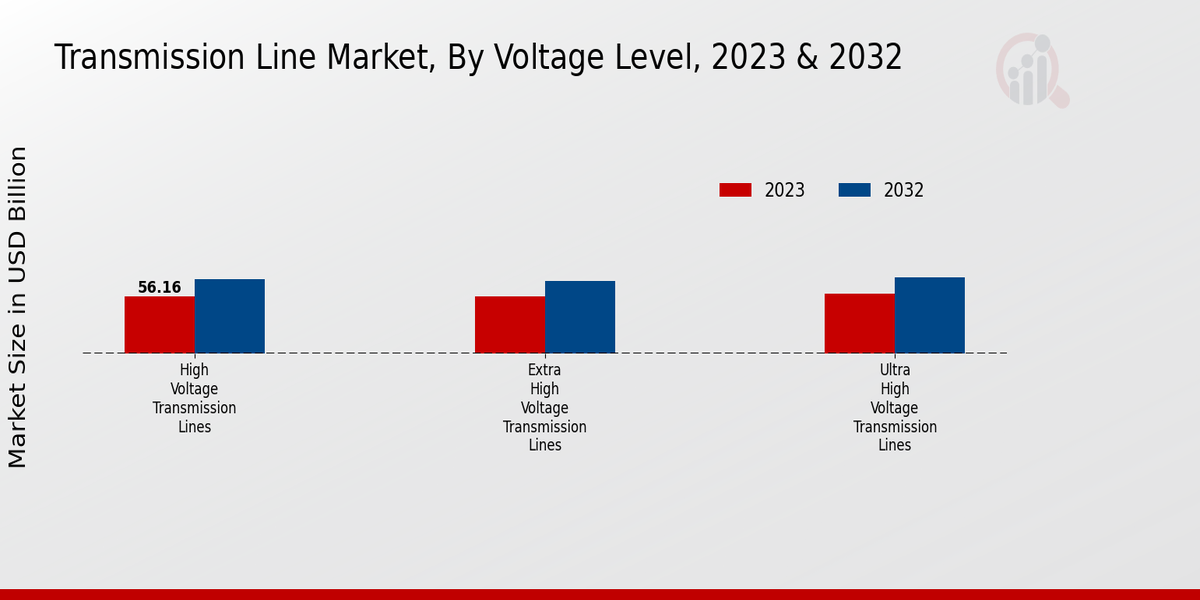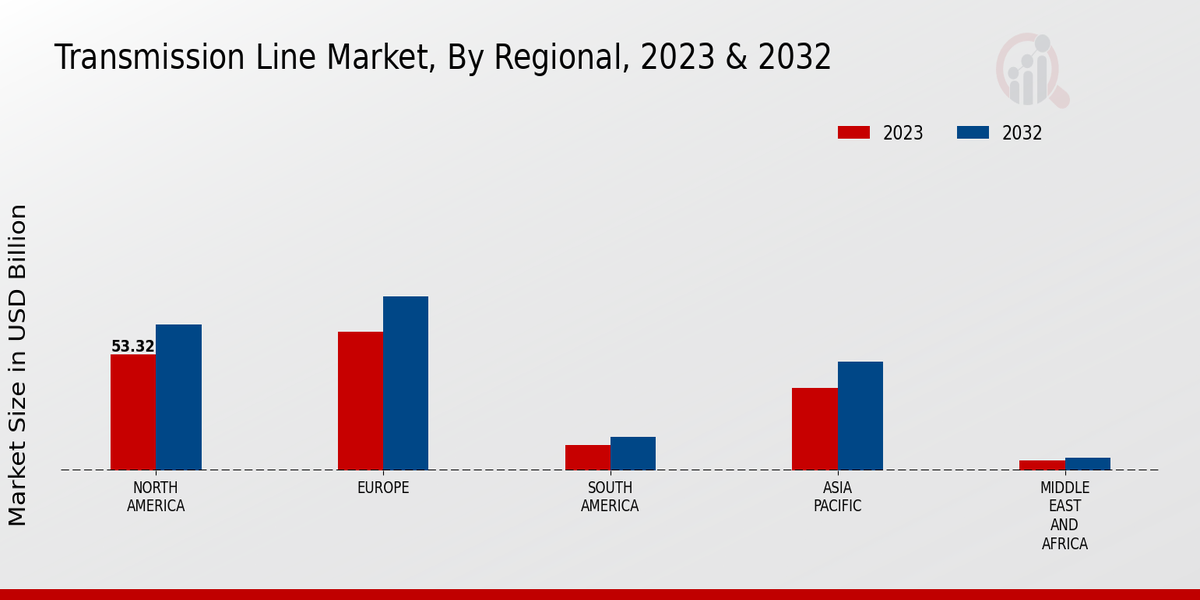Global Transmission Line Market Overview
As per MRFR analysis, the Transmission Line Market Size was estimated at 180.16 (USD Billion) in 2024. The Transmission Line Market Industry is expected to grow from 185.14 (USD Billion) in 2025 to 236.58 (USD Billion) till 2034, at a CAGR (growth rate) is expected to be around 2.76% during the forecast period (2025 - 2034).

Source: Primary Research, Secondary Research, MRFR Database and Analyst Review
Key Transmission Line Market Trends Highlighted
The Transmission Line Market is characterized by increasing demand for efficient and reliable power transmission systems. Key market drivers include rising electricity demand, expanding renewable energy installations, and growing urbanization. Governments and utilities are investing in upgrading and expanding their transmission infrastructure to meet these growing needs.
Opportunities for exploration in the transmission line market include the adoption of new technologies and materials. High-voltage direct current (HVDC) lines and advanced conductors are gaining traction due to their ability to transmit power over long distances with minimal losses. Additionally, there is a growing emphasis on underground and submarine transmission lines to minimize environmental impact and improve reliability.
Recent trends in the transmission line market include the integration of advanced monitoring and control systems. Smart grids and digital technologies enable real-time monitoring of transmission lines, allowing for predictive maintenance and improved fault detection. Furthermore, the use of drones and other aerial platforms for line inspections and maintenance is gaining popularity, reducing costs and improving safety.
Transmission Line Market Drivers
-
Increasing Demand for Renewable Energy Integration
The integration of renewable energy sources, such as solar and wind power, into the electrical grid is driving the demand for new transmission lines. These renewable energy sources are often located in remote areas, far from population centers. As a result, new transmission lines are needed to transmit the electricity generated by these renewable energy sources to consumers. The Transmission Line Market is expected to witness a significant rise in demand for new transmission lines in the coming years as the world continues to transition to a clean energy future.
Growing Population and Urbanization
The world's population is growing and becoming increasingly urbanized. This is leading to an increase in demand for electricity, which in turn is driving the need for new transmission lines. As cities grow, the demand for electricity increases to power homes, businesses, and infrastructure. This growth in demand is putting a strain on existing transmission lines, and new lines are needed to meet the growing demand.
Government Regulations and Policies
Government regulations and policies are also playing a role in the growth of the Transmission Line Market. Many governments are enacting policies that promote the use of renewable energy and reduce greenhouse gas emissions. These policies are driving the demand for new transmission lines that can transmit electricity from renewable energy sources to consumers.
Transmission Line Market Segment Insights
Transmission Line Market Voltage Level Insights
The Transmission Line Market is segmented by voltage level into high-voltage transmission lines, extra-high-voltage transmission lines, and ultra-high voltage transmission lines. The extra high voltage transmission lines segment is expected to hold the largest market share in 2023 and is projected to continue to grow at a steady pace over the forecast period.
This growth is attributed to the increasing demand for electricity transmission over long distances, as well as the need to improve the efficiency and reliability of power grids. The high voltage transmission lines segment is expected to witness significant growth over the forecast period, driven by the increasing deployment of renewable energy sources, such as solar and wind power.
These renewable energy sources are often located in remote areas, which requires the use of high voltage transmission lines to transmit the electricity to population centers. The ultra-high voltage transmission lines segment is expected to experience moderate growth over the forecast period.
These lines are typically used for long-distance transmission of electricity and are becoming increasingly popular as the demand for electricity continues to grow. Overall, the Transmission Line Market is expected to grow at a steady pace over the forecast period, driven by the increasing demand for electricity transmission and the need to improve the efficiency and reliability of power grids.
The extra high voltage transmission lines segment is expected to hold the largest market share, while the high voltage and ultra-high voltage transmission lines segments are expected to witness significant growth.

Source: Primary Research, Secondary Research, MRFR Database and Analyst Review
Transmission Line Market Conductor Material Insights
The Conductor Material segment of the Transmission Line Market is expected to witness significant growth over the forecast period owing to the increasing demand for efficient and reliable power transmission systems. Among the conductor materials, Aluminum Conductor Steel Reinforced (ACSR) held the largest market share in 2023 due to its high strength and low cost.
However, Aluminum Conductor Composite Core (ACCC) is projected to register the highest CAGR during the forecast period due to its enhanced thermal and electrical properties. Composite Core Conductors (CCC) are also gaining traction owing to their superior performance and reduced environmental impact.
Transmission Line Market Insulator Type Insights
The market segmentation provides valuable insights into the performance of different insulator types, enabling stakeholders to make informed decisions. Glass Insulators, with a market share of approximately 45% in 2023, have been widely used in transmission lines due to their high electrical resistance, low cost, and ease of installation.
However, their susceptibility to breakage and relatively heavy weight have led to the emergence of alternative insulator types. Polymer Insulators, gaining traction in the market, are projected to witness significant growth, capturing a market share of around 30% by 2032.
Their lightweight, high strength and resistance to pollution and aging make them a preferred choice for harsh environmental conditions. Composite Insulators, combining the advantages of glass and polymer insulators, offer superior electrical and mechanical properties. They are expected to account for a market share of approximately 25% by 2032, driven by their durability, low maintenance requirements, and ability to withstand extreme temperatures. The market dynamics and technological advancements in insulator types continue to shape the Transmission Line Market.
The choice of insulator type depends on various factors, such as voltage level, environmental conditions, and cost considerations, influencing the market growth and industry trends.
Transmission Line Market Tower Type Insights
The Transmission Line Market is segmented by Tower Type into Lattice Towers, Monopole Towers, and Guyed Towers. Lattice Towers dominate the market and are expected to continue their dominance over the forecast period. They are widely used due to their high strength-to-weight ratio, ease of construction, and cost-effectiveness. Monopole Towers are gaining popularity in urban areas due to their space-saving design and aesthetic appeal. Guyed Towers are preferred for crossing rivers, valleys, and other obstacles.
Transmission Line Market Application Insights
The Transmission Line Market segmentation by application comprises Electricity Transmission, Renewable Energy Integration, and Smart Grid Infrastructure. The Electricity Transmission segment held the largest revenue share in 2023. The growth of this segment is attributed to the increasing demand for reliable and efficient transmission of electricity over long distances. The Renewable Energy Integration segment is expected to witness the highest CAGR during the forecast period due to the growing adoption of renewable energy sources, such as solar and wind power.
The Smart Grid Infrastructure segment is also expected to experience significant growth, driven by the increasing investments in smart grid technologies to improve the efficiency and reliability of the power grid.
Transmission Line Market Regional Insights
The regional segmentation of the Transmission Line Market provides insights into the market's geographic distribution and growth potential. North America is anticipated to hold a significant market share due to the presence of developed economies with extensive transmission networks.
Europe is expected to lead, driven by the increasing adoption of renewable energy sources. The APAC region is projected to witness substantial growth due to rapid urbanization and industrialization, leading to increased demand for electricity transmission.
South America and MEA are also anticipated to contribute to the market's growth, albeit at a slower pace. Overall, the regional segmentation highlights the diverse growth opportunities across different geographic regions, with each region presenting unique market dynamics and competitive landscapes.

Source: Primary Research, Secondary Research, MRFR Database and Analyst Review
Transmission Line Market Key Players and Competitive Insights
Major players in the Transmission Line Market are consistently investing in research and development to improve their product offerings and gain a competitive edge. The transmission line market is expanding due to a growing emphasis on energy efficiency and the integration of renewable energy sources. Leading Transmission Line Market players are focusing on strategic partnerships to expand their market reach and enhance their product portfolio. The Transmission Line Market Competitive Landscape is characterized by intense competition, with several key players vying for market share.
A prominent player in the Transmission Line Market is ABB. The company offers a wide range of transmission line solutions, including overhead lines, underground cables, and substations. ABB has a strong global presence and a reputation for providing reliable and efficient products. The company is committed to innovation and has invested heavily in research and development to enhance its product offerings. ABB's focus on customer satisfaction and its ability to provide customized solutions have contributed to its success in the Transmission Line Market.
Another major player in the Transmission Line Market is Siemens. The company offers a comprehensive portfolio of transmission line products, including high-voltage overhead lines, underground cables, and substations. Siemens has a global presence and is known for its expertise in power transmission technology. The company is committed to sustainability and is investing in the development of environmentally friendly transmission line solutions. Siemens' strong brand reputation and its focus on innovation have made it a leading player in the Transmission Line Market.
Key Companies in the Transmission Line Market Include
- Nexans
- Elsewedy Electric
- Sumitomo Electric Industries
- Mitsubishi Electric
- Alstom
- NKT
- LS Cable System
- Prysmian Group
- Siemens
- General Electric
- Toshiba
- Hitachi
- Larsen Toubro
- KEC International
- ABB
Transmission Line Market Developments
The Transmission Line Market is projected to grow from USD 180.16 billion in 2024 to USD 236.58 billion by 2034, exhibiting a CAGR of 2.76% during the forecast period. The market growth is attributed to increasing electricity demand, growing investments in renewable energy sources, and the need for efficient transmission of electricity over long distances. Technological advancements, such as the integration of high-voltage direct current (HVDC) technology and the development of smart grids, are further driving market expansion.
Transmission Line Market Segmentation Insights
-
Transmission Line Market Voltage Level Outlook
- High Voltage Transmission Lines
- Extra High Voltage Transmission Lines
- Ultra-high Voltage Transmission Lines
-
Transmission Line Market Conductor Material Outlook
- Aluminum Conductor Steel Reinforced (ACSR)
- Aluminum Conductor Composite Core (ACCC)
- Composite Core Conductors (CCC)
-
Transmission Line Market Insulator Type Outlook
- Glass Insulators
- Polymer Insulators
- Composite Insulators
-
Transmission Line Market Tower Type Outlook
- Lattice Towers
- Monopole Towers
- Guyed Towers
-
Transmission Line Market Application Outlook
- Electricity Transmission
- Renewable Energy Integration
- Smart Grid Infrastructure
-
Transmission Line Market Regional Outlook
- North America
- Europe
- South America
- Asia-Pacific
- Middle East and Africa
| Report Attribute/Metric |
Details |
|
Market Size 2024
|
180.16 (USD Billion)
|
|
Market Size 2025
|
185.14 (USD Billion)
|
|
Market Size 2034
|
236.58 (USD Billion)
|
|
Compound Annual Growth Rate (CAGR)
|
2.76% (2025 - 2034)
|
|
Report Coverage
|
Revenue Forecast, Competitive Landscape, Growth Factors, and Trends
|
|
Base Year
|
2024
|
|
Market Forecast Period
|
2025 - 2034
|
|
Historical Data
|
2019 - 2023
|
| Market Forecast Units |
USD Billion |
| Key Companies Profiled |
Nexans, Elsewedy Electric, Sumitomo Electric Industries, Mitsubishi Electric, Alstom, NKT, LS Cable System, Prysmian Group, Siemens, General Electric, Toshiba, Hitachi, Larsen Toubro, KEC International, ABB |
| Segments Covered |
Voltage Level, Conductor Material, Insulator Type, Tower Type, Application, Regional |
| Key Market Opportunities |
High-voltage direct current HVDC transmission Underground transmission lines Smart grids Distributed generation Renewable energy integration |
| Key Market Dynamics |
Increasing demand for electricity Aging infrastructure Government regulations Technological advancements Environmental concerns |
| Countries Covered |
North America, Europe, APAC, South America, MEA |
Frequently Asked Questions (FAQ) :
The Transmission Line Market is expected to reach USD 180.16 billion in 2024 and is projected to Register a CAGR of 2.76% from 2025 to 2034, reaching USD 236.58 billion by 2034.
The key regions in the Transmission Line Market are North America, Europe, Asia-Pacific, and the Rest of the World. Asia-Pacific is expected to hold the largest market share due to increasing investment in infrastructure development and growing demand for electricity.
The major applications of transmission lines include power transmission, distribution, and interconnection of power systems. Transmission lines are used to transmit electricity from power plants to distribution centers and to connect different regions of the power grid.
The key competitors in the Transmission Line Market include ABB, Siemens, General Electric, Nexans, and Prysmian Group. These companies offer a wide range of transmission line products and services, including overhead lines, underground cables, and substation equipment.
Key trends in the Transmission Line Market include the increasing demand for renewable energy, the growing adoption of smart grid technologies, and the need to upgrade and expand existing transmission infrastructure.
The Transmission Line Market faces challenges such as the high cost of installation and maintenance, the need for right-of-way acquisition, and the environmental impact of transmission lines.
Opportunities for growth in the Transmission Line Market include the increasing investment in renewable energy, the growing demand for electricity, and the need to upgrade and expand existing transmission infrastructure.
The key factors driving the growth of the Transmission Line Market include the increasing demand for electricity, the growing adoption of renewable energy, and the need to upgrade and expand existing transmission infrastructure.
Potential risks to the growth of the Transmission Line Market include the high cost of installation and maintenance, the need for right-of-way acquisition, and the environmental impact of transmission lines.
Recent mergers and acquisitions in the Transmission Line Market include the acquisition of Linamar by Siemens and the acquisition of Prysmian Group by General Cable.

















